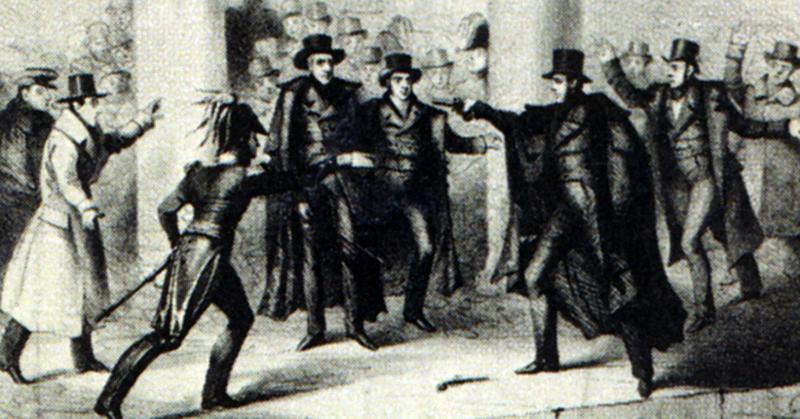The United States' First Ever Presidential Assassination Attempt (Andrew Jackson, 1835)
By | January 27, 2021

In 1835, Andrew Jackson almost became the first American president to be killed in office. At the time, there was no Secret Service and no one really keeping tabs on threats to the president, which makes Jackson's survival all the more miraculous. If it weren't for two misfiring guns and Jackson's predilection for hand-to-hand combat, history could have turned out very differently.
Richard Lawrence
Jackson's would-be assassin, Richard Lawrence, wasn't a Whig pawn or even all that political. After moving to the States from England when he was 12 years old, he worked as a house painter for most of his life and never caused any trouble until he succumbed to a mysterious mental illness. Historians believe toxic chemicals in the paint Lawrence used radically altered his personality in his thirties, when the once mild-mannered and conservatively presented young man began dressing flamboyantly, picking fights, and ordering people to refer to him as Richard III.
Not long before he attempted to assassinate President Jackson, Lawrence quit his job and announced that he was moving back to England but then declared evasively that it wasn't safe to travel. Over the next few weeks, he grew increasingly paranoid and unstable, following Jackson's movements while muttering aloud that Jackson was keeping him from acquiring a large sum of money. On the day that he decided to do something about it, witnesses saw him in his paint shop, holding a book and laughing, when he suddenly stood and declared "I'll be damned if I don't do it."

The Attempted Assassination Of Andrew Jackson
On January 30, 1835, Jackson was at the U.S. Capitol for the funeral of South Carolina Representative Warren R. Davis. Armed with two pistols, Lawrence followed the President to the Capitol Building with the intention of shooting him before the service, but he couldn't get to a close enough vantage point. The funeral went on undisturbed, but by the time Jackson left, Lawrence was ready.
As Jackson passed him, Lawrence leaped from behind a pillar on the East Portico and fired his first pistol at Jackson's back, but nothing happened. It turns out the gun had misfired, but Lawrence didn't have time for such technical troubleshooting. He fired with his second pistol ... and the exact same thing happened. About 100 years later, researchers at the Smithsonian Institute tested Lawrence's weapons and found nothing wrong with them. The odds of both pistols misfiring was about 1 in 125,000. It's believed now that the unusually wet and humid day, which may have dampened the gunpowder in Lawrence's pistols, is the only reason the President lived to see January 31.
Despite the anticlimactic action, Jackson couldn't help but notice that someone was trying to kill him and wasn't terribly thrilled about it, so he beat Lawrence over the head with his cane until the would-be assassin was rescued from the President by his own aides. In 1835, even at the age of 67 and in horrible health, Jackson was really not the guy you wanted to mess with: After being orphaned as a child, he was a prisoner of war at only 13 years old. Basically, he'd seen some stuff. He remains one of the toughest presidents who's ever held the office. Having recently butted heads with his opponents in the Whig Party over his dismantling of the Bank of the United States, he and much of his staff believed that the opposition party would stop at nothing, even murder, to get what they wanted—Vice President Martin Van Buren was so wary of the Whigs that he carried twin pistols with him whenever he visited the Senate—so Jackson was in even less mood than usual to put up with such nonsense.

Lawrence's Fate
Initially, Jackson believed Lawrence was in cahoots with his enemies in the Whig Party, with whom he had recently butted heads over his dismantling of the Bank of the United States (Vice President Martin Van Buren was so wary of the Whigs that he carried twin pistols with him whenever he visited the Senate), but it was clear at his trial that Lawrence was simply not in touch with reality. He wore a shooting jacket and cravat, continued to insist upon being called Richard III, and explained that he had to kill Jackson, who he claimed killed his father, to recover the considerable fortune Jackson was keeping from him and take his rightful place on the British throne.
It took the jury about five minutes to find Lawrence not guilty by reason of insanity. Prior to his judgement, Lawrence proclaimed "It is for me, gentlemen, to pass upon you, and not you upon me," and afterward, he spent the rest of his life in various mental institutions. In 1855, he was placed in the Government Hospital for the Insane in Washington, D.C., where he lived until his death on June 13, 1861.

